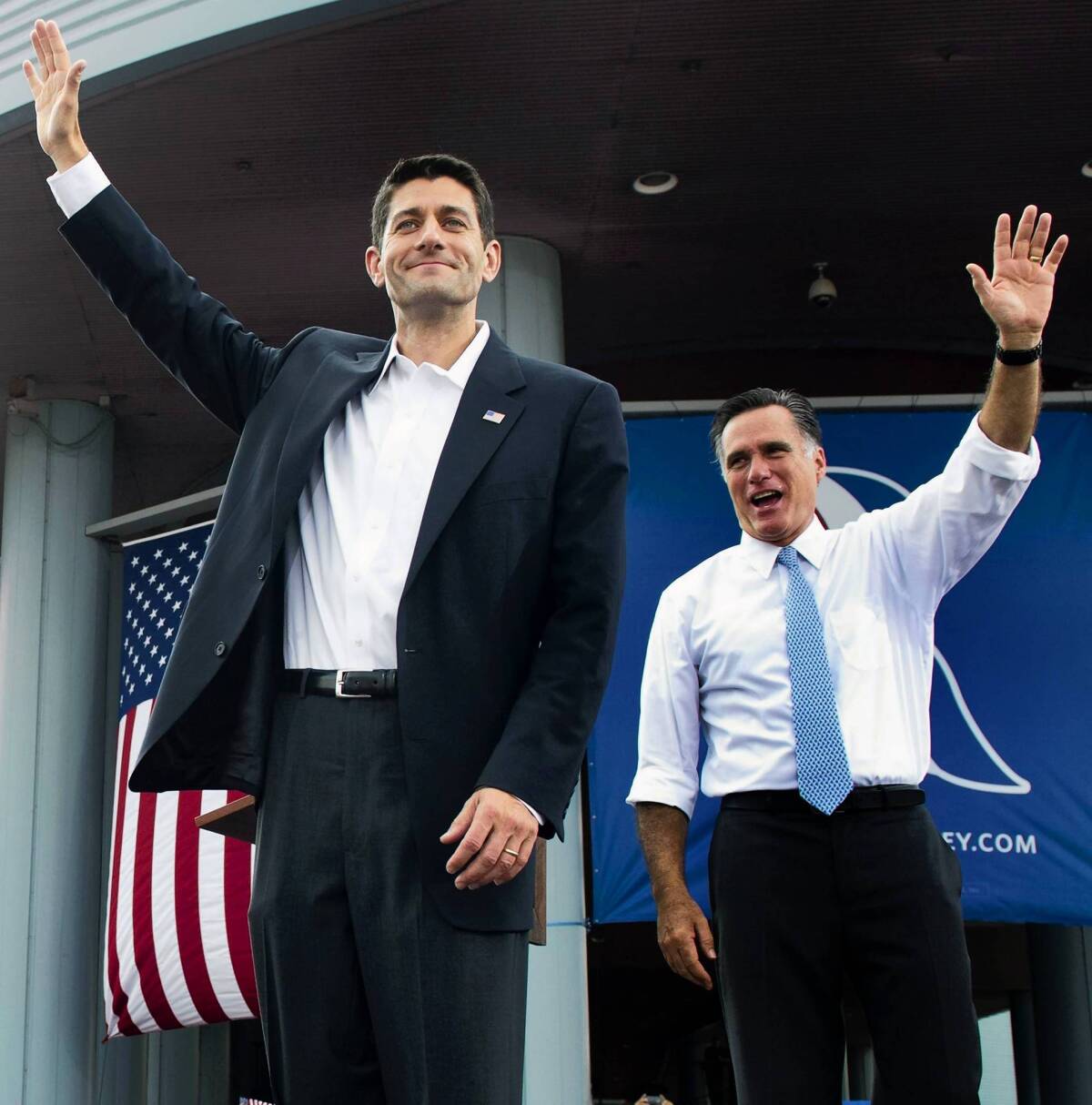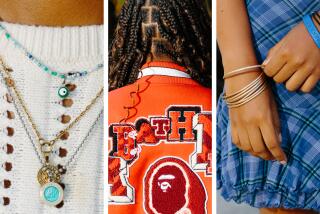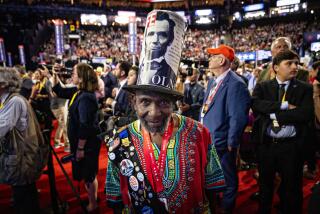Paul Ryan taken to task for fashion choices

Rep. Paul D. Ryan’s ill-fitting suit on the day he joined Mitt Romney as his running mate prompted several critiques.
- Share via
When Rep. Paul D. Ryan (R.-Wis.) billowed onto the national political stage in Norfolk, Va., as Mitt Romney’s vice presidential running mate this month, the reaction was swift and unanimous — at least among the fashion-focused.
Press pundits, fashion critics and men’s magazines bemoaned sartorial missteps such as a suit jacket so voluminous and ill-fitting it could have been inspired by David Byrne’s “Stop Making Sense” suit. Kurt Soller, writing for Esquire, described Ryan’s get-up as “a trash-bag black suit with a silhouette that would be great — if you were Herman Munster.” Words like “rumpled,” “ill-fitting” and “sloppy” peppered reports in the Washington Post, Women’s Wear Daily and New York magazine. Commentary was served up with a tone of bewilderment: Why was the ab-crunching adherent to the arduous P90X fitness program hiding his assets?
And the slings and arrows of social media took the pride of Janesville, Wis., to task for turning up sans necktie — the kind of symbolic jettisoning of the noose of corporate oppression that might have resonated if only Ryan weren’t essentially vying for the second most powerful corporate job in the free world.
“Everybody was commenting on it,” says Susan Abrams, a Los Angeles-based political image consultant. “I even saw other image consultants posting about the ill-fitting jacket on their Facebook pages, and I just thought: ‘That’s so not about the issues,’ but it really does play a role.”
Ryan is hardly the first politician whose sense of style (or lack thereof) has become part of the national conversation. Candidate Hillary Rodham Clinton was pilloried for her pantsuits, President Obama was derided for his dad jeans. Sarah Palin’s vice presidential candidacy sparked demand for Kawasaki 704 rimless eyeglass frames and upswept hairstyles — and made headlines when it was reported that the Republican National Committee had picked up a $150,000 tab for wardrobing her and some of her family.
One theory about why half the Republican ticket made his debut on the national stage looking like he was wearing hand-me-downs from the other half is that the rumpled Ryan in all his unfettered, bratwurst-making, bow-hunting glory offers a relatable counterweight to Romney’s focus-grouped sense of style. Asking him to switch up to a slimmer suit coat before entering the political arena might feel somehow inauthentic — akin to asking New Jersey Gov. Chris Christie to shed a few pounds before delivering the keynote speech at the National Republican Convention.
And, make no mistake about it, the way Ryan looked when he took the stage next to Romney was no last-minute wardrobe malfunction. Thanks to his 14-year career in the public eye, we’re able to confirm that the blousy, oversized dress shirt with the too-long arms, the rumpled trousers and the kiddie pool of a jacket have been staples of the Ryan wardrobe since his first run for public office in 1998.
Another constant seems to be the black digital watch strapped to Ryan’s left wrist — it can be seen in photos where he’s in workout gear and crossing his forearms into muscled X’s with P90X program creator Tony Horton, as well as at the Aug. 11 candidacy announcement. Post-announcement photos also show what appears to be an Apple iPhone holstered to Ryan’s belt — the less said about that fashion offense the better (at least with jackets as roomy as Ryan’s it won’t show.)
The MIA neckwear was a bit of a head scratcher though, since Ryan, chairman of the House Budget Committee, has a well-documented proclivity for wider and more garish than normal neckties. We’ve seen them fluttering in the wind as he trailed President George W. Bush down the steps of Air Force One in 2006 and draping his front like two-thirds of a purple-striped lobster bib when he introduced his “Path to Prosperity” budget recommendations on Capitol Hill in 2011.
Abrams says that tweaks to a candidate’s personal style can pay dividends to the overall campaign. “[I]t’s not about packaging someone to be phony, or in a way that doesn’t have authenticity or integrity,” she says. “It’s about presenting and projecting a message — whatever the campaign message is — through their behavior and their clothing. That’s the importance of it.”
For her part, Abrams says she wouldn’t have allowed any candidate to take to the political stage for an important announcement “without making some changes or revisions — and that’s true on almost any level from governor on up.”
“Sometimes the younger generation sort of bucks the traditional rules,” she says. “You see that a lot with celebrities and even young executives. But, when it comes to a national stage, that’s not where you make those sort of decisions.” In other words, Facebook’s Mark Zuckerberg might get a pass for wearing a hoodie to his IPO, but for the 42-year-old congressman at the heart of the veep-stakes, it’s a whole different ball game.
But according to Adam Galinsky, co-author of a recently published study on the psychological influences clothes have on the wearer (which he calls “enclothed cognition”), Ryan’s own mind-set is worth considering.
“There’s clearly a reason he does it,” Galinsky said. “People must have pointed out to him that his clothes are too big ... so it probably provides something psychologically comforting to him — confidence is a very important consideration. Or he could think it helps project a certain kind of image — of someone boyish and youthful who comes across as a non-Washington, D.C., insider. And it could be as simple as he’s a fitness fanatic and doesn’t want to feel like he’s constrained. It could well be an unconscious combination of all three.”
Maybe it’s our imagination, but, in the weeks since the announcement, there seems to have been a little improvement. The trousers that were visibly bagging around Ryan’s ankles as he and Romney stood atop twin wooden crates in Ashland, Va., later on in the day of his candidacy announcement have given way to Dockers khakis that break at just the right spot. His button-front shirts worn over crew-neck T-shirts (a red-and-white check in Iowa, a blue-and-white button-down collar shirt in Colorado), though not body-hugging by any means, at least look like he’s wearing his own size — though it’s hard to tell based on the sleeve length since he’s been wearing them rolled up to mid-forearm in a possible show of working-class solidarity. He’s been accessorizing with thick brown leather belts, and the squarish-toed shoes that earned him poor marks out of the gate — “one of the most grievous mistakes a man can make,” Women’s Wear Daily fretted — seem to have been kicked to the curb in favor of cowboy boots. Altogether he looks appropriately dressed for the never-ending casual Friday of the campaign trail. (Well, except for the inexplicably casual striped short-sleeve polo shirt he wore to a Florida campaign stop on Aug. 18.)
But the real test will come when it’s time to play dress-up again — with the kickoff of the Republican National Convention on Monday. When the ardent fan of Ayn Rand slips back into a suit coat, will it still be so big that if Atlas did shrug we’d be able to tell? Abrams thinks the convention will provide the perfect opportunity for Ryan to make what she calls a “second first impression.”
“[The campaign] still has the ability to go in and make changes — to show that he can look casual and still have the attention to detail that’s appropriate for a vice presidential image. If they do that, all of this will disappear as a topic of interest.”
Galinsky doesn’t see any downside to a potential sartorial switch-up.
“If he comes out on stage at the RNC convention with an impeccably tailored suit that perfectly fits his body it will fit that narrative of ‘he’s kind of grown-up now and stepping into a vice presidential role.’
“I don’t know if that could hurt him — and if he psychologically sees it that way, it wouldn’t undermine his confidence.”
It doesn’t even need to be high fashion. A dress shirt altered to fit perfectly, a tailored jacket that nips in ever so slightly at the waist and a natty (but not-too-wide) necktie would be just the ticket.
More to Read
Get the L.A. Times Politics newsletter
Deeply reported insights into legislation, politics and policy from Sacramento, Washington and beyond. In your inbox three times per week.
You may occasionally receive promotional content from the Los Angeles Times.











